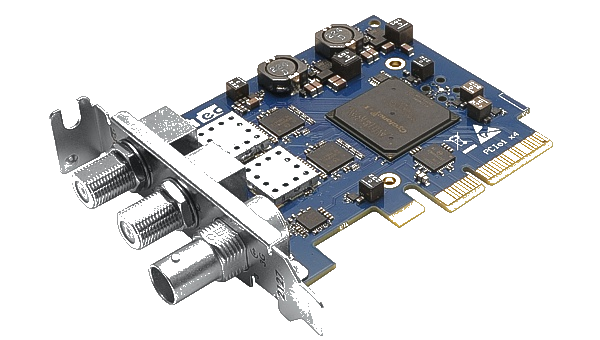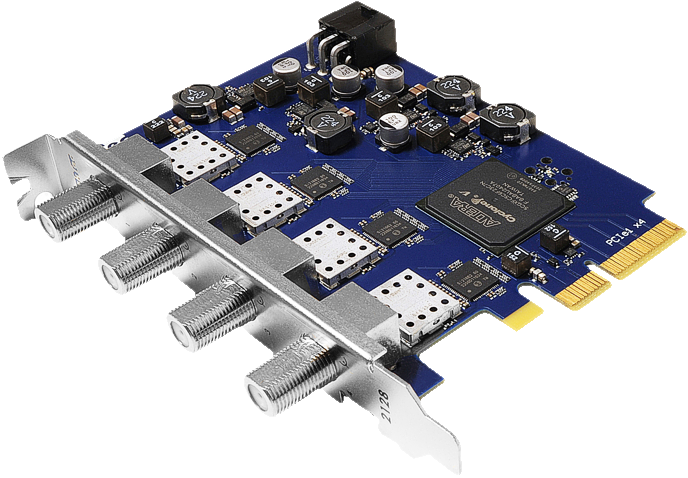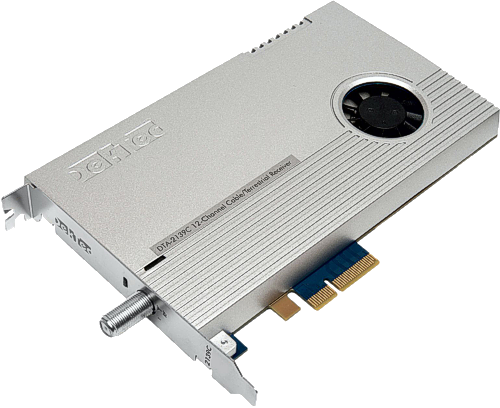|
Digital-TV Receivers for Monitoring, Redistribution and Analysis DekTec’s line of digital-TV receivers includes multi-channel hardware-demodulator models that operate with zero CPU load. For maximum flexibility, SDR-based models offer full-channel demodulation and advanced RF analysis features such as transfer function plotting. Typical applications include off-air monitoring, re-multiplexing, signal quality analysis, and lab testing.
|
| DTA-2127 | DTA-2128 | DTA-2131B | DTA-2132 | DTA-2139C | |
 |
 |
 |
 |
 |
|
|
List priceThe suggested retail price for the product. Quantity discounts and OEM arrangements may apply. Please direct OEM queries directly to one of the DekTec offices.
|
€ 515 | € 515 | € 1.068 | € 1.785 | € 1.400 |
| Cable, terrestrial | |||||
| Satellite | |||||
| SDR - CPU assisted | partial | ||||
| Hardware demod | |||||
| #RF inputs | 2 | 4 | 1 | 1 | 1 |
| #Demodulators | 4 | 8 | 1 | 1 | 12 |
| RF band | L band | L band | VHF, UHF | L band | VHF, UHF |
| RF range | 950 .. 2150MHz | 950 .. 2150MHz | 42 .. 1002MHz | 950 .. 2150MHz | 42 .. 1002MHz |
| RF connector | 75-Ω F female | 75-Ω F female | 75-Ω F female | 75-Ω F female | 75-Ω F female |
| #ASI outputs | 1 | 0 | 0 | 0 | 0 |
|
Low-profile PCIeLow profile PCIe cards are 'half height', for mounting in a low-profile PC case. DekTec cards come standard with a full-height bracket and a separate low-profile bracket in the box.
Add -LP to the model number to order a card with a low-profile bracket already mounted. |
|||||
| PCI Express | Gen1 x4 | Gen1 x4 | Gen1 x1 | Gen2 x4 | Gen1 x4 |
|
Standards included with the base product |
|||||
| DTA-2127 | DTA-2128 | DTA-2131B | DTA-2132 | DTA-2139C | |
|
ATSC 1.0Standard: ATSC A/53E
"ATSC 1.0", launched in 1996, is the designation used (retroactively) to describe the first digital terrestrial standard developed by the Advanced Television Systems Committee (ATSC).ATSC 1.0 uses 8-level vestigial sideband modulation (8VSB) in a 6MHz channel. The symbol rate is fixed to 10.76MBd, giving a net bitrate of 19.39Mbit/s. ATSC 1.0 is used primarily in North America and in Korea. |
|||||
|
ATSC 3.0Standard: ATSC A/300, Korea TTAK.KO-07.0127
Where conventional standards use MPEG-2 transport streams, ATSC 3.0 is fully IP based. This enables hybrid broadcast and broadband service delivery e.g. for personalized advertisements. OFDM modulation with LDPC error correction are used to deliver multiple physical layer pipes (PLPs) with IP content over terrestrial networks. ATSC 3.0 modulation is used primarily in North America and in Korea. Note: Korea uses a different version of the standard that is incompatible with the standard used in North America. |
|||||
|
DVB-C2Standard: ETSI EN 302 769
DVB-C2 is the second generation of DVB cable transmission system offering greater than 30% higher spectrum efficiency. It uses new OFDM-based channel coding schemes, combined with higher level modulation modes up to 4K QAM. DVB-C2 has limited distribution around the world with only few countries doing trials. |
|||||
|
DVB-CIDStandard: ETSI TS 103 129 v1.1.2
DVB-CID (Carrier ID) is a signal embedded in a satellite signal. It allows satellite operators and end users to identify the source of a satellite carrier, even when it can no longer be demodulated due to interference. CID is modulated using spread spectrum techniques. This means the signal can be injected at noise level, so that the impact of the CID signal on the MER of the satellite signal is negligible. |
|||||
|
DVB-SStandard: ETSI EN 300 421
DVB-S for digital satellite broadcasting was the first digital-TV modulation standard released by DVB (1995). It has been used extensively for contribution feeds and for direct to home (DTH) broadcasting. DVB-S is a relatively straightforward system using QPSK, Reed-Solomon forward error correction and bit interleaving. DVB-S has been used all over the world but is now replaced by DVB-S2 which is more efficient. |
|||||
|
DVB-S2Standard: ETSI EN 302 307
DVB-S2 is a second generation standard for satellite television. It uses higher level modulation modes up to 256APSK and powerful LDPC error correction for better spectrum efficiency than DVB-S. It is used all over the world. |
|||||
|
DVB-S2XStandard: ETSI EN 302 307 part 2
DVB-S2X is an extension of DVB-S2 with higher spectral efficiency. It offers smaller roll-off options of 5% and 10% and a finer gradation of coding modes. It also supports very low C/N down to -10dB for mobile applications, e.g. maritime and trains. DVB-S2X is mostly used for contribution. |
|||||
|
DVB-T2Standard: ETSI EN 302 755
Second generation terrestrial modulation standard introduced in 2009. DVB-T2, like its predecessor DVB-T, uses orthogonal frequency-division multiplexing (OFDM). Compared to DVB-T, a key new concept is the use of one or more "physical layer pipes" (PLPs), each of which potentially can use different channel coding. DVB-T2 is used in Europe and parts of Asia. |
|||||
| I/Q samples | |||||
|
ISDB-TStandard: ARIB STD-B21
ISDB-T is a Japanese terrestrial modulation standard introduced in 2003. It uses frequency-domain multiplexing of OFDM signals into 13 'segments' of the spectrum. Services can be assigned to one or more segments segments, providing service flexibility. ISDB-T is used in Japan, other parts of Asia and South America. |
|||||
|
J.83BStandard: ITU-T J.83 Annex B, also known as "J.83B" or "QAM-B"
First-generation cable-modulation standard based on QAM modulation with 7-bit symbols (customary is 8 bits), Reed-Solomon forward error correction, symbol interleaving, and 64- or 256-QAM. J.83B is mainly used in North America and Korea. |
|||||
|
QAM-CStandard: ITU-T J.83 Annex C
First-generation cable-modulation standard based on QAM modulation. Very similar to QAM-A (=DVB-C), only the roll-off factor is different (QAM-A:0.15, QAM-C:0.13). QAM-C is used in parts of Asia. |
|||||
|
Software |
|||||
| DTA-2127 | DTA-2128 | DTA-2131B | DTA-2132 | DTA-2139C | |
|
Atsc3XpertAtsc3Xpert - Reception and analysis software for ATSC 3.0 signals. Features of Atsc3Xpert include:
1. Decoding and visualisation of all ATSC 3.0 signaling information. 2. Advanced RF measurements: transfer function, impulse response and constellation diagram. 3. Sending the received ATSC 3.0 stream to StreamXpert for A/V decoding and full table analysis. 4. Forwarding the received ATSC 3.0 stream over IP in ALP or ROUTE/MMT format. 5. Capturing PLP data as IP in a PCAP file. |
|||||
|
C2XpertC2Xpert - Reception and analysis software for DVB-C2 signals. Features of C2Xpert include:
1. Shows all DVB-C2 modulation parameters and signalling details. 2. Advanced RF measurements including transfer function, impulse response and constellation diagram. 3. Gathers statistics about #LDPC iterations required to correct all errors. 4. Shows history of #required LDPC iterations in a graph. |
|||||
|
StreamXpertStreamXpert - DekTec's industry-standard analyzer software for transport streams and OTT. It analyzes and decodes many popular audio, video and metadata formats in real time, including new formats such as ATSC 3.0.
The software operates directly on any receiver card. The tuning parameters can be set and the stream can be analyzed in real time. Alternatively, the StreamXpert can record the received stream to disk for offline analysis at a later time. |
|||||
|
T2XpertT2Xpert - Reception and analysis software for DVB-T2 signals. Features of T2Xpert include:
1. Shows all DVB-T2 modulation parameters and signalling details. 2. Advanced RF measurements including transfer function, impulse response and constellation diagram. 3. Gathers statistics about #LDPC iterations required to correct all errors. 4. Shows history of #required LDPC iterations in a graph. |
|||||
|
VF-RECVF-REC - Advanced TS/SDI recording software. It allows you to record and playback transport streams or uncompressed SDI streams in the lab, for development and testing, for demos, etc.
VF-REC is especially suited for making long or circular (e.g. last day) recordings for later off-line analysis. |
|||||
|
Miscellaneous |
|||||
| DTA-2127 | DTA-2128 | DTA-2131B | DTA-2132 | DTA-2139C | |
| Power consumption | 6.1W | 9.0W | 5.5W | 14W | 11.4W |
|
LxHxD cardProduct dimensions. For PCI Express cards, dimensions exclude the PCIe bracket.
|
85 x 69 x 16mm | 85 x 112 x 15mm | 120 x 69 x 16mm | 120 x 69 x 15mm | 167 x 111 x 16mm |
|
LxHxD fullDimensions of the full product, including bracket.
For low-profile PCI Express cards, the dimensions of the product with the low-profile bracket mounted are shown. |
101 x 80 x 19mm | 111 x 126 x 18mm | 140 x 80 x 19mm | 131 x 80 x 18mm | 187 x 125 x 19mm |